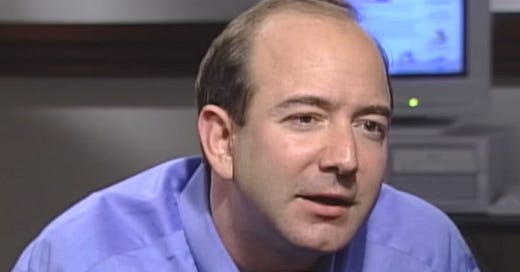The Secret Sauce Behind Amazon's Weekly Business (WBR) Review - Part 2
A Journey Through Time and Data
Amazon's Secret Weapon: Simplicity in the Age of Complexity
Now that we've taken a deep dive into the world of statistical process control and XmR charts (in part-1), you might be wondering, "What does all this have to do with Amazon?" Well, my dear reader, everything. When Jeff Bezos was building Amazon from a humble online bookstore to the "everything store" we know today, he knew he needed a way to keep his finger on the pulse of the business. Enter the Weekly Business Review (WBR), powered by – you guessed it – good old-fashioned Statistical Process Control.
As detailed in the book "Working Backwards" by Colin Bryar and Bill Carr, Bezos didn't just implement metrics for the sake of having pretty charts to look at during meetings (though I'm sure he appreciated a good color-coded graph as much as the next tech billionaire). No, he instilled a culture of metrics that mattered – metrics that told a story, highlighted problems, and pointed the way toward solutions.
The Birth of Amazon's WBR
Picture this: It's the early 2000s. Amazon is growing faster than kudzu on a Southern porch, and Bezos realizes he needs a way to keep track of it all without drowning in data. Inspired by the principles of Deming and Wheeler, he introduces the Weekly Business Review.
The WBR wasn't just another boring meeting where executives recited numbers like a corporate poetry slam. It was a deep dive into the metrics that really mattered, using tools like XmR charts to separate the signal from the noise.
Bezos vs. The PowerPoint Menace
Now, here's where things get interesting. While most companies were busy creating PowerPoint decks with enough bullet points to make a firing squad jealous, Bezos took a different approach. He banned PowerPoint presentations in executive meetings.
Yes, you read that right. The man looked at the corporate world's favorite crutch and said, "Nah, we're good." Instead, he insisted on six-page narrative memos. Why? Because bullet points are where nuance goes to die, and context is king when you're trying to understand complex business dynamics.
These narrative memos weren't just a collection of metrics. They were stories, complete with context, analysis, and proposed actions. And at the heart of these stories? You guessed it – charts and graphs that showed not just where the business was, but where it had been and where it might be going.
The Power of the Right Metrics
Bezos understood something that many business leaders miss: not all metrics are created equal. He was ruthless in focusing on the metrics that truly mattered – the ones that gave insight into the health and direction of the business.
Take, for example, Amazon's focus on free cash flow per share. While many companies were obsessing over profit margins or revenue growth, Bezos recognized that free cash flow was a better indicator of Amazon's long-term health and ability to invest in future growth.
Or consider their customer-centric metrics like the Negative Free Cash Flow model. Instead of just looking at how much money customers were spending, Amazon tracked how quickly they were able to pay back the initial cost of acquiring that customer. It's the kind of metric that makes accountants weak in the knees and gives marketing teams nightmares, but it perfectly encapsulates Amazon's long-term thinking.
XmR in Action at Amazon
While we can't peek inside Amazon's actual WBR (unless you've got some serious hacking skills or a really convincing Jeff Bezos costume), we can imagine how they might use XmR charts to track critical metrics.
Let's say they're monitoring the average time it takes to fulfill an order. An XmR chart would allow them to:
See the overall trend: Is fulfillment time increasing, decreasing, or holding steady?
Identify unusual spikes: Maybe there was a massive influx of orders on Prime Day that threw things off.
Spot gradual shifts: Perhaps fulfillment time is slowly creeping up, indicating a need for process improvements or additional capacity.
By using these charts, Amazon can distinguish between normal variation (like slightly longer fulfillment times during the holiday rush) and special causes that require immediate attention (like a warehouse robot uprising – hey, it could happen).
The Dashboard Deluge: A Cautionary Tale
Now, you might be thinking, "This all sounds great! I'm going to run back to my office and create dashboards for everything!" And that, dear reader, is where so many companies go wrong.
In today's data-obsessed business world, many companies are drowning in a sea of dashboards, awash in an ocean of metrics, floundering in a... well, you get the idea. They're tracking everything from website bounce rates to the average number of coffee beans used per employee cappuccino. (Okay, I made that last one up, but admit it – you briefly wondered if it was a real metric, didn't you?)
The Dashboard Fallacy
Here's the dirty little secret that dashboard vendors don't want you to know: More data doesn't equal more insight. In fact, too much data can be worse than not enough. It's like trying to find a specific tree while staring at a hi-res satellite image of the entire Amazon rainforest. (The actual rainforest, not the company. Although come to think of it, the metaphor works either way.)
Many companies fall into the trap of thinking that if they just track enough metrics, insights will magically appear. They end up with dashboards that look like the control panel of a nuclear reactor, but with less clarity on what to do when things go wrong.
The Metrics Mirage
Even worse are the companies that focus on vanity metrics – numbers that look good in a PowerPoint presentation but don't actually tell you anything useful about your business. It's like weighing yourself ten times a day while on a diet of nothing but celery and sadness. Sure, the number might go down, but are you really getting healthier?
These companies might celebrate a spike in website traffic, not realizing it's because their latest ad went viral for all the wrong reasons. Or they might panic over a dip in social media engagement, unaware that it's because their target audience is busy, you know, having a life outside of Instagram.
The Analysis Paralysis Epidemic
And then there are the companies that have good data, relevant metrics, and even fancy XmR charts, but still can't seem to make a decision. They're so afraid of making the wrong move that they end up making no move at all. It's like watching a deer in the headlights, if the deer was wearing a suit and staring at a Bloomberg terminal.
These companies hold meeting after meeting, analyzing every blip and squiggle on their charts, debating whether that 0.01% change in customer retention is statistically significant or just a rounding error. Meanwhile, their more decisive competitors are eating their lunch, dinner, and probably stealing their midnight snacks too.
The Path Forward: Be More Like Bezos (In This Specific Way)
So, what's a data-conscious company to do in this age of metrics madness? Take a page from Bezos's book:
Focus on what matters: Identify the key metrics that truly drive your business. If a metric doesn't help you make decisions, it's just noise.
Embrace context: Use tools like XmR charts to understand the story behind the numbers. A spike or a dip is meaningless without understanding the larger pattern.
Act on insights: Data is useless if it doesn't lead to action. Be prepared to make decisions based on what your metrics are telling you.
Keep it simple: You don't need a dashboard that rivals the NASA control room. A few well-chosen metrics, properly understood, are worth more than a thousand vanity data points.
Think long-term: Don't get caught up in day-to-day fluctuations. Look for trends and patterns that give insight into the long-term health of your business.
Remember, the goal isn't to have the most metrics or the prettiest dashboards. It's to understand your business deeply enough to make informed decisions. Or, as Bezos might say, to work backwards from what truly matters to your customers and your business's long-term success.
So the next time you're tempted to create yet another dashboard or track yet another metric, ask yourself: What would Bezos do? (Hint: It probably involves a six-page memo and a healthy dose of skepticism towards any metric that doesn't directly tie to customer value.)
In the end, the secret sauce of Amazon's Weekly Business Review isn't about having the most advanced technology or the most complex algorithms. It's about having the wisdom to focus on what matters, the courage to face the truth in the data, and the determination to continuously improve.
And who knows? Maybe someday, you'll be the one writing a best-selling book about how you used these simple yet powerful techniques to build the next Amazon. Just remember to thank Deming, Wheeler, and yes, even this humble blog post, in your acknowledgments.
Now, if you'll excuse me, I need to go check my XmR chart tracking the number of bad jokes per blog post. I have a feeling I might be approaching the upper control limit... but then again, in the world of dad jokes, is there really such a thing as too many?






